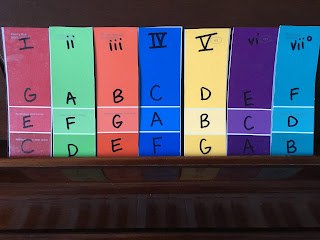Musical Snow Boots and Tuxedos?!
I introduced these Good Better Best Activities (Good Better Best Rhythmic Dictation , Good Better Best Melodic Dictation, Good Better Best Dice Composing) in our monthly piano group lesson but wanted to explore a bit further with some students in private lessons by teaching them how to choose primary chords that would sound good with the melody they created using this Good Better Best Composing Sheet and Good Better Best Chant.Choosing Chords that Match the Melody
A Good Match: Songs sound better when the chord matches the melody. You wouldn't usually wear high heels with a bathing suit or wear snow boots with a tuxedo because they just don't mix! Music sounds more pleasing when you choose chords (bottoms) that match your melody (tops). Start by choosing a primary chord (I, IV or V) to play at the beginning of each measure that includes the note from your melody that you dictated previously. Write the chord symbol (I, IV or V) or letter name (C, F or G) above the measure in your music. Once you are satisfied with the sound, write the chords in the bass clef or add them into Finale.
For example, in the key of C if you play a C in the melody you could choose either a C chord (CEG) or F chord (FAC), but G (GBD) clashes because there is no C in the chord.
Tip: Displaying just the I, IV and V chord strips makes it easier for students to choose chord tones in the primary triads

Finish the Song Strong
Ending on the I chord with "Do" as the last note in the melody makes your song sound finished, kind of like ending a sentence with a period. Ending with a V-I Chord progression (perfect cadence) gives an even stronger feel of finality, like an exclamation point!Good, Better or Best!
A good melody is better with some chord harmony, but to make your song sound the best, add some dynamics and articulation marks. Could adding an accent, staccato, fermata or crescendo help to emphasize the message of your song?
Related Posts:




.png)





No comments:
Post a Comment